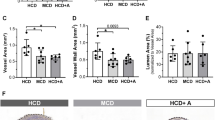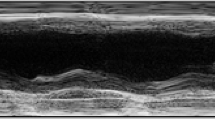Abstract
Purpose: HGF, one of endothelium-specific growth factors, might contribute to the repair process of vascular endothelial cell damage, suggesting that serum HGF concentration may be elevated in patients with arteriosclerosis. However, the cardiac metabolism of HGF has not been examined in patients with coronary artery disease (CAD). We examined the levels of hepatocyte growth factor (HGF) in the coronary circulation and its correlation with the severity of arteriosclerosis in patients with CAD.
Methods: We measured serum HGF concentration obtained from the coronary sinus (CS) and ascending aorta (AA) in patients with atherosclerotic CAD (Group E, n = 33) or vasospastic angina (Group V, n = 26), or normal control subjects (Group N, n = 12). In Group E, the severity of coronary artery stenosis was evaluated using the Gensini's score.
Results: Serum HGF concentrations (ng ml) in the CS were 0.112 ± 0.008 in Group E (p < 0.001 vs. Group V, p < 0.001 vs. Group N), 0.197 ± 0.012 in Group V (p = 0.031 vs. Group N), and 0.245 ± 0.021 in Group N. Serum HGF concentrations in the AA were 0.282 ± 0.014 in Group E (p = 0.045 vs. Group V, p = 0.021 vs. Group N), 0.246 ± 0.012 in Group V, and 0.237 ± 0.009 in Group N. Serum HGF extraction in the heart (HGF in the AA-HGF in the CS) in Group E (0.170 ± 0.018) was significantly higher compared with in Group V (0.049 ± 0.011) or Group N (0.008 ± 0.005). There was a significant negative correlation between the severity of coronary arteriosclerosis and serum HGF concentration in CS (r = −0.66, p < 0.001), and a significant positive correlation between the severity of coronary arteriosclerosis and HGF extraction in the heart (r = 0.75.p < 0.001).
Conclusions: We conclude that the difference of HGF levels between CS and AA in patients with CAD are decreased, and extent of decreases in HGF levels correlates with the severity of coronary arteriosclerosis. The abnormality of HGF metabolism in the heart may contribute to the progression of coronary arteriosclerosis.
Similar content being viewed by others
References
Nakamura Y, Morishita R, Higaki J, et al. Hepatocyte growth factor is a novel member of the endotheliumspecific growth factors: Additive stimulatory effect of hepatocyte growth factor with basic fibroblast growth factor but not with vascular endothelial growth factor. J Hypertens 1996; 14:10 67-72.
Bussolino F, Di RenzoMF, Ziche M, et al. Hepatocyte growth factor is a potent angiogenic factor which stimulates endothelial cell motility and growth. J Cell Biol 1992; 119:6 29-41.
Nishimur M, Ushiyama M, Nanbu A, Ohtsuka K, Takahashi H, Yoshimura, M. Serum hepatocyte growth factor as a possible indicator of arteriosclerosis. J Hypertens 1997; 15:11 37-42.
Nakamura S, Moriguchi A, Morishita R, et al. Anovel vascular modulator, hepatocyte growth factor (HGF), as a potential index of the severity of hypertension. Biochem Biophys Res Commun 1998; 242:2 38-43.
Morishita R, Nakamura S, Nakamura Y, et al. Potential role of endothelium-specific growth factor, hepatocyte growth factor, on endothelial damage in diabetes mellitus. Diabetes 1997; 46:1 38-42.
Nakamura T. Structure and function of hepatocyte growth factor. Prog Growth Factor Res 1991; 3: 67-86.
Matsumoto K, Nakamura T. Role of HGF as a pleiotropic factor in organ regeneration. In: Goldenberg ID, Rosen EM, ed. Hepatocyte Growth Factor-Scatter Factor (HGF-SF) and C-Met Receptor. Basel, Switzerland: BirkhauserVerlag, 1993; 2 25-49.
Boros P, Miller CM. Hepatocyte growth factor: A multifunctional cytokine. Lancet 1995; 345: 293-95.
Nakamura Y, Motishita R, Higaki J, et al. Expression of local hepatocyte growth factor system in vascular tissues. Biochem Biophys Res Commun 1995; 215:4 83-88.
Nakano N, Moriguchi A, Morishita R, et al. Role of angiotensin II in the regulation of a novel vascular modulator, hepatocyte growth factor (HGF), in experimental hypertensive rats. Hypertension 1997; 30:14 48-54.
Nakano N, Kida I, Nakamura T, Morigushi, A. Differential response of an endothelium-specific growth factor, hepatocyte growth factor, by treatment of an angiotensin converting enzyme inhibitor and an angiotensin II receptor antagonist in balloon injury model. Circulation 1997; 96: I-99.
Hayashi S, Morishita R, Nakamura S, et al. Potential role of hepatocyte growth factor, a novel angiogenic growth factor, in peripheral arterial disease: downregulaton of HGF in response to hypoxia in vascular cells. Circulation 1999; 100:II3 01-08.
Matsumori A, Furukawa Y, Hashimoto T, et al. Increased circulating hepatocyte growth factor in the early stage of acute myocardial Infarction. Biochem Biophys Res Commun 1996; 221:3 91-95.
Yamazaki H, Oi H, Matsushita M, et al. Heparin induces rapid and remarkable elevation of hepatocyte growth factor/ scatter factor during trans arterial emblization of renal cell carcinoma. Anticancer Res 1997; 17:14 35-37.
Gensini GG. A more meaningful scoring system for determining the severity of coronary heart disease. Am J Cardiol 1993; 51: 606.
Tsubouchi H, Niitani Y, Hirono S, et al. Levels of the human hepatocyte growth factor in serum of patients with various liver diseases determined by an enzyme-linked immunosorvent assay. Hepatology 1991; 13: 1-5.
Tomiya T, Nagoshi S, Fujiwara K. Significance of serum human hepatocyte growth factor levels in patients with hepatic failure. Hepatology 1992; 15: 1-4.
Yanagita K, Nagaike M, Ishibashi H, Niho Y, Matsumoto K, Nakamura T. Lung have an endocrine function producing hepatocyte growth factor in response to injury of distal organs. Biochem Biophys Res Commun 1992; 182:8 02-09.
Kono S, Nagaike M, Matsumoto K, Nakamura T. Marked induction of hepatocyte growth factor mRNA in intact kidney and spleen in response to injury of distant organs. Biochem Biophys Res Commun 1992; 186:9 91-98.
Ishiki Y, Ohnishi H, Muto Y, Matsumoto, K, Nakamura T. Direct evidence that hepatocyte growth factor is a hepatotrophic factor for liver regeneration and has a potent antihepatitis effect in vivo. Hepatology 1991; 16:12 27-35.
Hamanoue M, Takao S, Shimazu H, Noji S, Matsumoto K, Nakamura T. Rapid and marked induction of hepatocyte growth factor during liver regeneration after ischemic or crush injury. Hepatology 1992; 16:14 85-92. Local HGF and Coronary Arteriosclerosis 153
Kugiyama K, Ohgushi M, Motoyama T, et al. Nitric oxidemediated flow-dependent dilation is impaired in coronary arteries in patients with coronary spastic angina. J Am Coll Cardiol 1997; 30:9 20-26.
Yamagishi M, Miyatake K, Tamai J, Nakatani S, Koyama J, Nissen SE. Intravenous ultrasound detection of atherosclerosis at the site of focal vasospasm in angiographycally normal or minimally narrowed coronary segments. J Am Coll Cardiol 1994; 23:3 52-57.
Koyama J, Yamagishi M, Tamai J, Kawano S, Daikoku S, Miyatake K. Comparison of vessel wall morphologic appearance at sites of focal and diffuse coronary vasospasm by intravascular ultrasound. Am Heart J 1995; 130:4 40-45.
Shinozaki K, Suzuki M, Ikebuchi M, et al. Insulin resistance associated with compensatory hyperinsulinemia as an independent risk factor for vasospastic angina. Circulation 1995; 92:17 49-57.
Petrie JR, Ueda S, Webb DJ, Elliott HL, Connell JMC. Endothelial nitric oxide production and insulin sensitivity. A physiological link with implications for pathogenesis of cardiovascular disease. Circulation 1996; 93:13 31-33.
Matsumoto K, Tajima H, Okazaki H, Nakamura T. Negative regulation of hepatocyte growth factor gene expression in human lung fibroblasts and leukemic cells by transforming growth factor-beta 1 and glucocorticoids. J Bio Chem 1992; 267:249 17-20.
Gohda E, Matsunaga T, Kataoka H, Yamamoto I. TGF-beta is a potent inhibitor of hepatocyte growth factor secretion by human fibroblasts. Cell Biol Int Rep 1992; 16:9 17-26.
Nikol S, Isner M, Pickering JG, Kearney M, Leclerc G, Weir L. Expression of transforming growth factor-β1 is increased in human vascular restenosis lesions. J Clin Invest 1992; 90:15 82-92.
Powell JS, Clozel JP, Muller RK, et al. Inhibitors of angiotensin-converting enzyme prevent myointimal proliferation after vascular injury. Science 1989; 245:1 86-88.
Thuillez C, Mudler P, Elfertak L, et al. Prevention of endothelial dysfunction in small and large arteries in a model of chronic heart failure. Effect of angiotensin converting enzyme inhibition. Am J Hypertens 1995; 8: 7S-12S.
Dohi Y, Criscione L, Pfeiffer K, Luscher TF. Angiotensin blockade or calcium antagonists improve endothelial dysfunction in hypertension: Studies in perfused mesenteric resistance arteries. J Cardiovasc Pharmacol 1994; 24:3 72-79.
Novosel D, Lang MG, Noll G, Luscher TF. Endothelial dysfunction in aorta of the spontaneously hypertensive, stroke-prone rat effects of therapy with verapamil and trandolapril alone and in combination. J Cardiovasc Pharmacol 1994; 24:9 79-85.
Piana RN, Wang SY, Friedman M, Sellke FW. Angiotensinconverting enzyme inhibition preserves endotheliumdependent coronary microvascular responses during shortterm ischemia-reperfusion. Circulation 1996; 93:5 44-51.
Isner JM, Pieczek A, Schainfeld R, et al. Clinical evidence of angiogenesis after arterial gene transfer of phVEGF165 in patient with ischaemic limb. Lancet 1996; 348:3 70-74.
Schumacher B, Pecher P, von Specht BU, Stegmann TH. Induction of neoangiogenesis in ischemic myocardium by human growth factors: First clinical results of a new treatment of coronary heart disease. Circulation 1998; 97:6 45-50.
Author information
Authors and Affiliations
Rights and permissions
About this article
Cite this article
Watanabe, K., Fukuda, H., Sueda, S. et al. Metabolism of Hepatocyte Growth Factor in the Heart in Patients with Coronary Artery Disease: Implication for Coronary Arteriosclerosis. Cardiovasc Drugs Ther 15, 147–153 (2001). https://doi.org/10.1023/A:1011174913176
Issue Date:
DOI: https://doi.org/10.1023/A:1011174913176




